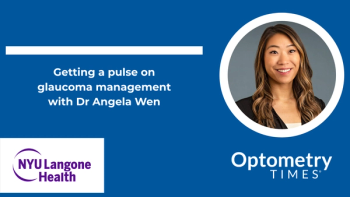
- October digital edition 2021
- Volume 13
- Issue 10
Beyond anxiety in patients with glaucoma
Emotional health can potentially affect patient care, study results show
It is widely understood that emotional health is a significant part of overall health. Depression and anxiety have the capacity to affect a person physically. I was recently challenged by a friend on how anxiety could influence physical health. Rather than cite numerous peer-reviewed references, I simply pointed to the notion of stage fright. The classic scenario would be feeling sick in the bathroom before giving that big speech.
Numerous professions exist in which workers can be de facto frontline anxiety identifiers. Recent pushes aim to train hairstylists to detect signs and symptoms of domestic violence. I know my barbershop is a place for conversation, and I am in and out in 15 minutes. I could only imagine how much conversation could take place between a stylist and a customer who was there long enough to let highlights process, for example.
Listen to your patients
Health care workers are obviously in this position, and eye care is no different.
Physically, ODs are in a position to detect signs of abuse. I can recall a vitreous hemorrhage in a young child with no clear history of trauma and no apparent underlying systemic condition, which would predispose to such. ODs are also in a position to hear their patients and listen to what they are telling them—both verbally and nonverbally.
Depression and anxiety have been shown to be higher in patients with glaucoma compared with patients without glaucoma.1These conditions can affect how patients respond to clinical recommendations. Study results recently published in BMJ Open Ophthalmology pointed to emotional health as having a potential impact on patient care.2
This study, which was cross-sectional in design, included 100 patients from the glaucoma and retina divisions of the Wilmer Eye Institute in Baltimore, Maryland (40 from the glaucoma service and 60 from the retina service). Each patient filled out the Patient Health Questionnaire (PHQ-9) for depression and the Generalized Anxiety Disorder (GAD-7) tool to determine the likely presence and severity of depression and/or anxiety, respectively. The scores and results were given to each patient’s ophthalmologist just prior to an eye examination (the study included 10 ophthalmologists). After the examination was over, the ophthalmologists filled out questionnaires regarding whether the patients’ scores for depression and/or anxiety changed the clinical approach regarding communication, treatment, follow-up, etc.
Of the patients included in the study:
» 20% showed no signs of anxiety or depression per the surveys filled out prior to the examinations
» 48% showed minimal anxiety or depression as their worst score on the surveys
» 27% showed mild to moderate depression or anxiety as their worst score
» 5% showed moderate to severe depression or anxiety
» 2% had suicidal thoughts
As for the questionnaires filled out by the doctors after the examinations were over, 90% said they paid attention to depression and anxiety in their assessment of their patients, 90% stated they found the questionnaire useful, and 100% stated they did not think ophthalmologists were adequately trained on how depression and anxiety could affect treatment adherence. Further, 82% reported that they did not change their behavior based on the patient scores. No doctor changed treatment based on the patient scores. Some 99% did not change follow-up for any patients based on the patient scores. However, some 4% did refer a patient to a social worker or psychologist/psychiatrist for further care based on the results of the patient scores.
Conclusion
Regarding this study, self-reported survey questions could always pose limitations because they rely on the accuracy of responses.
However, the results are compelling in that they suggest that knowledge of a patient’s emotional health status (using the study language) could have an impact on patient care. Going further, note that the 4% of patients referred out for further care as per their anxiety/depression scores may have been missed without knowledge of their scores by their doctors. Four percent is a significant number of patients.
References
1. Mabuchi F, Yoshimura K, Kashiwagi K, et al. High prevalence of anxiety
and depression in patients with primary open-angle glaucoma. J
Glaucoma. 2008;17(7):552-557. doi:10.1097/IJG.0b013e31816299d4
2. Naufal F, Gajwani P, Medina R, Dutson M, Mariotti SP, West SK.
Knowledge of patient emotional health status: impact on clinical
care in glaucoma and retinal services. BMJ Open Ophthalmol.
2021;6(1):e000640. doi:10.1136/bmjophth-2020-000640
Articles in this issue
about 4 years ago
The future of physician waiting roomsabout 4 years ago
How to drop a vision plan and replace revenueabout 4 years ago
Top 9 sports vision resourcesabout 4 years ago
Demodex: Recognize it and treat itabout 4 years ago
Approach patients with low vision on an individual basisabout 4 years ago
Central serous retinopathy is not a benign diseaseabout 4 years ago
Use OCT to determine scleral lens clearanceover 4 years ago
Delta COVID-19 variant forcing meeting changesNewsletter
Want more insights like this? Subscribe to Optometry Times and get clinical pearls and practice tips delivered straight to your inbox.










































